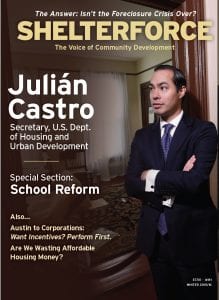
This generally grinds a conversation to a halt because faltering schools are often seen, at best, as outside a community development groups’ skill set to address, and, at worst, as entrenched messes that are just too complicated for anyone to fix. Schools are usually run by a separate set of elected officials from the ones CDCs typically work with. They are something of their own worlds, beset by a thicket of conflicting expert opinions on what should be done to improve them. Thus, schools were for a long time too daunting for many community development groups to put on their agenda.
There were always exceptions of course—Shelterforce has written about the overlap over the years, and even held a convening on community-school partnerships. Developer Richard Baron, in his recent interview with us says he threatened to walk away from the New Orleans C. J. Peete public housing redevelopment if it didn’t have a school associated with it.
Recently, however, school reform has become one of the most hot button issues of the day, polarizing people who would otherwise be political allies.
Community activists, racial justice advocates, and public school advocates argue that corporate-backed “education reform” is harming poor communities. Meanwhile, many community development financial institutions have become major financers of charter schools (The Charter School Lenders and Why Are Community Development Lenders Financing Charter Schools?), and many CDCs have included charter schools in their organizational toolboxes (Above the Fray). Could it be that education work involving real estate feels more within community development’s wheelhouse than other school advocacy?
It’s important, however, to understand the larger context in which that tool is operating, and the ripple effects it has. The common narrative has been that American schools are failing, but the numbers reveal that when you control for poverty our schools are doing just fine. The schools are failing certain kids, whom our society has failed first. Unfortunately, the political solution of late has been to withhold resources and latitude to address their students’ higher needs properly, and instead create assessments designed to show these schools failing, and then “punish” those schools by privatizing them or authorizing more competing charter schools that further drain their funds. Privatizing public education is seen as the big new Wall Street investment opportunity, even while reports of fraud, lack of accountability, and sham nonprofits run rampant.
The community development world, however, is often working at the neighborhood level, not at the level of a whole school district, or state education policy. There is an understandable tension between the immediacy of wanting to help children who are not getting what they need right now, and taking responsibility for the long-term direction of an entire community’s school system.
That is to say, an individual charter school can certainly be good (they aren’t always) for the specific children who attend them, and still be part of an overall privatization trend that leaves behind the most vulnerable (Why Are Community Development Lenders Financing Charter Schools?). Places like D.C., where the school choice experiment is farther along, are starting to experience backlash and a call for neighborhood schools (Don’t Call It a Comeback for Neighborhood Schools).
This does not mean community development should ignore schools. There are many ways community developers can support a better education for the residents of the areas where they work (Engaging the Public Schools: Are You Ready?, Above the Fray?, Schools That Support Students’ Whole Lives, Gentrification and Public Schools: It’s Complicated). It is possible to have successful public schools in areas of high poverty and diversity—see what’s happening in London, Cincinnati, and Jennings, Mo.. There are also ways to make charters better at furthering equity (Charter Schools, Gentrification, and Weighted Lotteries and The Place-Based Charter School?). And it doesn’t have to be all or nothing; many community groups get involved with both public schools and charters (Above the Fray?).
Still, let’s always keep one eye on the larger forces at work. Many communities might turn away a big-box store despite needing jobs and affordable retail because of its longer-term depressing effect on wages, increased public assistance, and harm to local businesses. Similarly, the end game of a privatized education system may look very different than the one shiny new charter schools seemed to promise.
Also in this issue we explore how Austin, Texas, is trying to go beyond paying companies to set up shop there and see how its economic development ordinance can be a force for increasing equity (More Bang for the Buck?). And we examine the quiet problem of temporary affordability that is built into nearly all our affordable housing funding (Have We Been Wasting Affordable Housing Money?).






With the highest concentration of failing schools in the state of Tennessee, the Frayser community in Memphis has been ground zero for efforts to improve schools. Frayser CDC has not pretended to be expert at education, so has stayed out of the battles over charter vs public, etc. We have tried to support all schools that are here.
We have recently received funding and the a green light to attack blighted houses adjoining 2 schools under new managemnt in an effort to help make those schools more successful. Our data show that we can lower crimes rates dramatically when we deal with abandoned properties. We have always looked for concrete ways to link our work with the other important efforts going on here. This, for us, is a step forward and an appropriate way to use our skills to support progress in education.